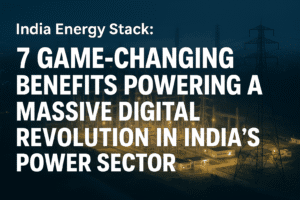India Energy Stack: 7 Game-Changing Benefits Powering a Massive Digital Revolution in India’s Power Sector
India’s Ministry of Power is building a transformative digital backbone called the India Energy Stack (IES) to modernize its electricity sector. This Digital Public Infrastructure (DPI) aims to overcome fragmentation by creating a secure, interoperable platform for the entire energy value chain. Key features include unique digital IDs for assets and consumers, real-time consent-based data sharing, and open APIs to foster innovation. Inspired by the success of Aadhaar and UPI, Power Minister Khattar envisions IES enabling seamless renewable integration, boosting DISCOM efficiency, and empowering consumers with better services.
A 12-month pilot program will test the concept using a Utility Intelligence Platform with DISCOMs in Mumbai, Delhi, and Gujarat. An expert task force will guide development and a national rollout strategy, with a White Paper forthcoming for public input. Ultimately, IES seeks to deliver transparent, reliable, and future-ready power essential for India’s economic growth and net-zero goals.

India Energy Stack: 7 Game-Changing Benefits Powering a Massive Digital Revolution in India’s Power Sector
Forget clunky systems and fragmented data. India’s power sector is poised for a digital revolution as transformative as UPI was for payments. Announced by the Ministry of Power, the newly conceived ‘India Energy Stack’ (IES) aims to be the foundational digital backbone – the ‘operating system’ – for the nation’s entire electricity ecosystem.
Why Now? The Imperative for a Digital Power Grid:
India’s ambitious goals – a $5 trillion economy and Net Zero commitments – rest heavily on a modern, efficient power sector. Yet, the rapid surge in renewable energy, electric vehicles, and dynamic consumer participation is straining legacy systems. DISCOMs struggle with inefficiency, grid integration of renewables remains complex, and consumers lack seamless tools for engagement. Fragmented data and incompatible systems are the roadblocks. The IES is the Ministry’s answer: a unified Digital Public Infrastructure (DPI) designed to overcome these hurdles.
Decoding the India Energy Stack: More Than Just Tech
Think of IES not as a single app, but as a secure, open platform enabling seamless interaction across the entire electricity value chain – generation, transmission, distribution, and consumption. Its core pillars promise fundamental change:
- Universal Identity & Traceability: Unique digital IDs for everything – consumers, meters, transformers, EV chargers, even transactions. This eliminates ambiguity and enables granular tracking.
- Real-Time, Consent-Driven Data Flow: Imagine secure, standardized data sharing (like generation forecasts, grid load, consumption patterns) only with explicit consent and in real-time. This transparency is crucial for efficiency and innovation.
- Open API Architecture: The ‘Lego blocks’ approach. Developers, utilities, and startups can build applications and services (billing, analytics, EV management, DER integration) that plug directly into the IES ecosystem, fostering rapid innovation.
- Empowerment & Market Access Tools: Equip consumers with tools to understand usage, access dynamic pricing, participate in demand response, or even sell rooftop solar power back to the grid easily. Empower DISCOMs with better analytics for loss reduction and planning.
The Vision: Powering a Citizen-Centric Future
Power Minister Shri Manohar Lal Khattar drew a powerful parallel: “What Aadhaar did for identity and UPI achieved for payments, the India Energy Stack will accomplish for the power sector.” The vision is clear: unlock transparent, reliable, and future-ready power services for every Indian citizen and business.
Tangible Outcomes: From Pilot to Powerhouse
This isn’t just a whiteboard concept. The Ministry is backing the IES with concrete action:
- Proof of Concept (PoC): A 12-month real-world test is launching. Partnering with DISCOMs in Mumbai, Gujarat, and Delhi, the PoC will pilot the Utility Intelligence Platform (UIP) – a modular analytics application built on IES. Expect real-time grid insights, predictive maintenance, and smarter consumer engagement tools.
- Expert Task Force: A dedicated cross-functional team (tech, power sector, regulation) is steering the IES’s design, pilot, and eventual national scale-up.
- Public Roadmap: A forthcoming White Paper will open the concept for public consultation, ensuring broad input before finalizing the national rollout strategy.
Why This Matters: The Human & Economic Impact
The IES isn’t just about tech; it’s about tangible benefits:
- For Consumers: Expect simpler processes (connections, billing, complaints), potential cost savings through better tariffs/demand management, and active participation in the energy market (e.g., selling solar power).
- For DISCOMs: Gain powerful tools to reduce AT&C losses, optimize operations, integrate renewables smoothly, and improve financial health – potentially lowering the need for subsidies.
- For Renewables & Grid Stability: Enable seamless large-scale integration of solar and wind, crucial for India’s clean energy transition and grid resilience.
- For Innovation & Economy: The open API platform is a launchpad for Indian startups and businesses to build novel energy solutions, creating jobs and driving sectoral growth.
The Road Ahead: Building the Digital Grid
The India Energy Stack represents a bold reimagining of how India manages its power. By creating a secure, interoperable digital foundation, it aims to tackle fragmentation, empower stakeholders, and unlock the efficiency needed to fuel India’s growth sustainably. The success of the pilot projects in Mumbai, Delhi, and Gujarat will be the crucial first step in proving this vision. If it delivers on its promise, the IES could indeed become the UPI moment for Indian power – invisible infrastructure enabling a revolution in how we generate, distribute, and consume electricity. The digital backbone for India’s energy future is under construction.
You must be logged in to post a comment.